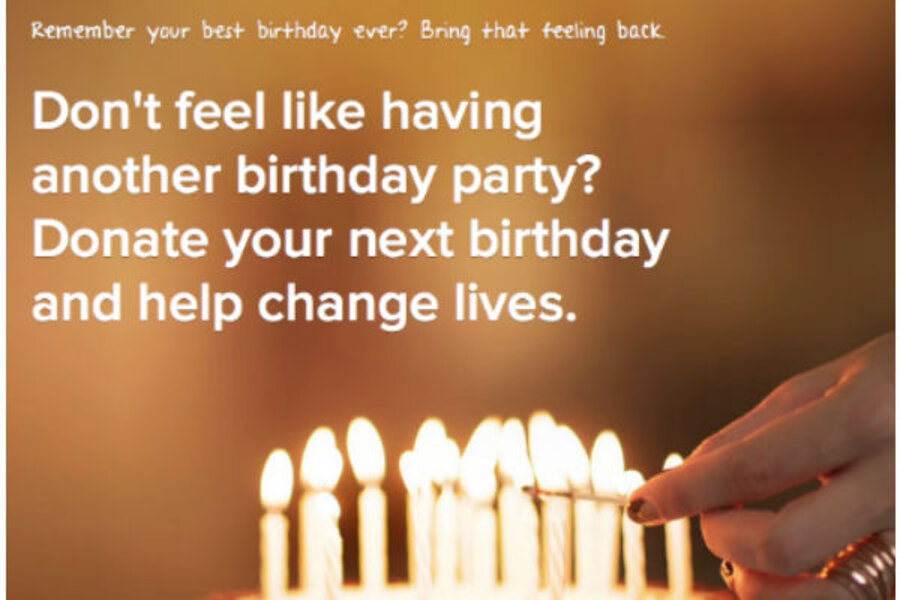Birthday party: Parents help take kids from 'gimme' to giving
Loading...
When Leo Kagan, a 10-year old from Massachusetts, first heard about children suffering and dying from lack of access to clean water, he felt immediately moved to action.
“I just feel terrible that people are dying because of dirty water, and I want to act,” says Leo. For his 10th birthday in 2013, he chose to “give up his birthday” to charity:water, raising money for clean water through a donation campaign in lieu of a birthday celebration.
Leo is among almost 60,000 individuals who have taken the pledge to replace their birthday with charitable gifts through this single organization. Charity:water estimates that more than $9 million dollars has already been raised through this giving format and Leo’s efforts last year netted just over $1,300 towards the organization’s sweeping efforts to bring clean water to communities in need around the world.
Many of us probably know adults who have chosen to fund-raise for cancer research or donated a goat or cow through Heifer International for birthdays or a holiday present, but it seems especially inspiring when the decision comes from a child.
In advance of their birthdays, many kids are probably thinking about their party theme, who they will invite, and what gifts they want. Families are feeling the pressure – I myself have succumbed to an attempt at birthday party overachieving – it seems to have become de rigeur these days to give your child a Pinterest-worthy party.
Leo’s estimation is this: “I think kids just don't understand the scale of the problem and need to be taught that giving to people in need feels just as great as getting a birthday present.”
Additionally, as the holidays approach, children might also be thinking about what they hope they will receive for Christmas or Hanukkah. In their Parents section, the Today Show noted that some parents and their children even fill out registries (yes, like for weddings and babies) for their holiday gifts.
While that last idea might begin to conjure in you some of the same ire you might feel seeing Halloween candy in the drugstore aisles before school begins, there are ways that children can be guided towards more balance in their understanding of what it means to receive and to give.
Teaching our children to be caring starts as soon as they begin to interact with others, but understanding privilege, selflessness, and generosity are much bigger issues. If we want to instill a lifelong giving spirit, our approach has to go beyond one single event and become part of the family culture. Many parents I spoke to have created new family traditions around giving at birthdays and during the holidays and beyond.
“[We] clean out toys and clothes between seasons, before Christmas...and talk about how and why we are giving them away,” says Becky Alley, a former preschool teacher and mother of two.
It’s true that setting a great example provides powerful incentives from those who are closest to our children: parents. However, it also seems clear that children are most often, and most powerfully, influenced by their peers.
Mom Lakshmi Rao says that her son Arnav was inspired by a friend in daycare, first at age 4, to donate to a food bank for his birthday. For their family, the approach is all about balance.
“I give him a choice each year. He likes the idea of donating and getting something he really wants from us instead of a lot of other things he would've received and is probably not interested in playing with more than once,” says Ms. Rao. Arnav is empowered to choose for himself one gift he really desires and he can continue to share the enjoyment of his altruistic tradition.
The role of parents here is critical, teaching children there is not just a choice but also a meaningful opportunity, to give. For Leo’s campaign, social media has been paramount in helping him spread the word, however, having a mom who works in marketing doesn’t hurt either. Seeing direct results and support builds kids’ confidence in giving. In Leo’s case, based on the results he has seen, he has pledged to make an even bigger impact as he turns 11.
Whenever a child opts to forgo a gift bounty to give to others, it is still appropriate to find ways to honor them. I ask Leo’s mother, Marta Kagan, how she and Leo’s father, Jake, celebrated his choice.
She says that in addition to helping him set up his campaign and reaching out to friends and colleagues to support him, they praised him for his choice.
However, they soon discovered that beyond their support, the biggest gift to Leo was watching how others responded to his campaign.
Marta says, “It was very rewarding to see how excited he was every time a new donation was made – which included not only a dollar value but also how many people would get clean water as a result. He loved the notes people sent him too.”





